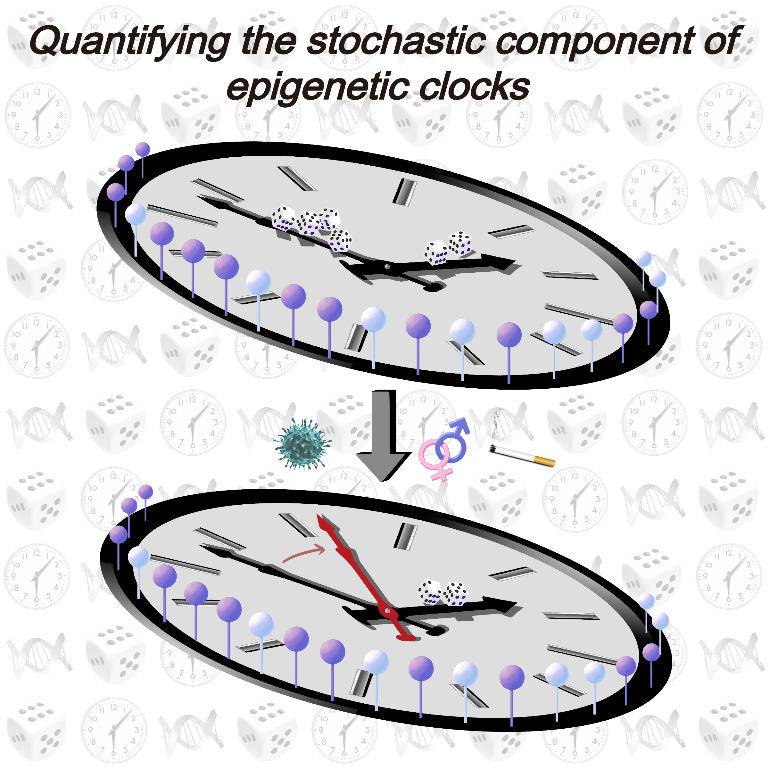Over a decade ago, it was observed that an epigenetic covalent modification of DNA, known as DNA methylation (DNAm) is altered with age in a manner that is largely cell and tissue-type independent. Soon thereafter, epigenetic DNAm-clocks were developed that, given a subject’s DNA sample, can fairly accurately predict the chronological age of that person, and to some extent also this person’s biological age. By now, the epigenetic clock field has rapidly grown and blossomed into one of the most exciting and broad areas of research, covering diverse fields as healthy aging, geriatrics, ecology, forensics, psychology and social sciences. Epigenetic clocks have been shown to be applicable to any mammalian species and are being used to test the efficacy of anti-aging and cellular rejuvenation strategies, among many other applications. However, with the exception of epigenetic mitotic clocks, the underlying biological mechanisms underlying these clocks are still shrouded in mystery.
A team led by Professor Andrew Teschendorff from the Shanghai Institute of Nutrition and Health, Chinese Academy of Sciences, has now shed substantial novel insights into the workings of epigenetic clocks in a study published in Nature Aging. The researchers elegantly demonstrate that a significant component of epigenetic clocks arises from biological mechanisms that induce stochastic DNAm changes. In particular, they show that the more accurate an epigenetic clock is in predicting chronological age, the greater the underlying stochastic component of the clock is. Conversely, epigenetic clocks that are better at predicting biological age, have a stronger non-stochastic component. In other words, according to Prof. Andrew Teschendorff, processes that increase or decrease biological age are inherently non-stochastic, whilst the normal ticking of the clock is determined by an inherently stochastic process of DNAm change accrual.
According to Andrew Teschendorff “This elucidates the dichotomy of chronological vs biological age, and although at first it may sound surprising that a stochastic process can lead to a very accurate predictor of chronological age, this result follows from relatively simple mathematics, as the stochasticity of the DNAm changes in single-cells is averaged out over a cell population”. The net effect averaged over a cell population is a linear change in the cumulative DNAm-change. Conversely, known biological processes that lead to age-acceleration, for instance activation of detoxification pathways in response to smoking, are inherently non-stochastic. As remarked by Andrew Teschendorff, these insights are important because it was previously thought that biological age-acceleration may simply reflect an increased rate of stochastic DNAm change accrual, yet the data from his lab shows that this is not the case. As demonstrated in their work, the only exception to this rule are epigenetic mitotic clocks, where an increased mitotic age in cancer or preneoplastic lesions is reflected by an increase rate of stochastic DNAm-change accrual, indicating that DNAm-changes associated with cell-division are inherently stochastic.
This work was published in Nature Aging under the title “Quantifying the stochastic component of epigenetic aging” on 9th May 2024.
This work was funded by the Chinese Academy of Sciences and National Natural Science Foundation of China. Most of the datasets analyzed in the manuscript are publicly available.

Top panel: The clock represents the epigenetic clock, with the ticking of the clock and accuracy in predicting chronological age determined by a stochastic process, symbolized here by the rolling dice near the hands of the clock. The epigenetic nature of the clock, characterized by DNA methylation changes that change slowly with age, is symbolized by the lollipops on the circumference of the clock, whose colors (representing binary DNA methylation) change gradually with age (symbolized here by the position on the circumference). Lower panel: As a result of disease risk factors (e.g. viral infections, smoking, gender), the clock may display age-acceleration, symbolized by the turning of the “minute-hand” with the absence of dice indicating that the underlying process is non-stochastic. The dice on the “hour-hand” are meant to indicate that stochastic processes are still present. The age-acceleration is also symbolized with the increase rate at which lollipops change their DNA methylation state. (Image provided by Prof. Andrew Teschendorff's group)
Media Contact:
WANG Jin
Shanghai Institute of Nutrition and Health,
Chinese Academy of Sciences
Email: wangjin01@sinh.ac.cn
Web: http://english.sinh.cas.cn/

